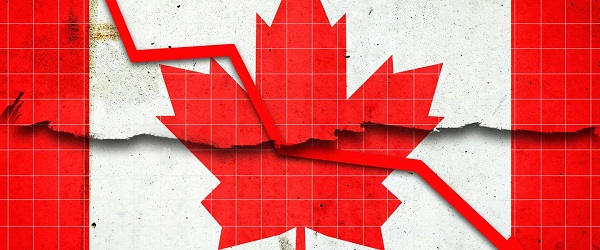Business
Fiscal update reveals extent of federal government mismanagement

From the Fraser Institute
By Jake Fuss and Grady Munro
Following the sudden departure of Chrystia Freeland as finance minister, the Trudeau government released its 2024 fall fiscal update on Monday. Unsurprisingly, spending is up, the deficit has ballooned even higher, and the Trudeau government continues to utterly mismanage Canada’s finances.
Let’s get into the numbers.
For the current fiscal year (2024-25), the update estimates the federal government will spend $543.4 billion while taking in $495.2 billion in revenues. This means the government plans to run a $48.3 billion deficit—$8.5 billion higher than the $39.8 billion deficit that had originally been planned just eight months ago.
The Trudeau government’s incessant need to introduce new spending at every turn has driven this increase in borrowing. Indeed, discretionary spending on programs is now expected to be $6.1 billion higher than initially projected in this year’s budget tabled in April. Revenues have also taken a hit compared to projections from the spring, primarily from the federal government’s new GST holiday.
Not only will the government run a larger deficit this year, but future deficits are also expected to rise. Cumulative deficits from 2025-26 to 2028-29 are now expected to be $14.9 billion higher than projected in the spring budget.
There are costs associated with running deficits and accumulating debt, and Canadians ultimately bear these costs. Just like anyone who takes out a loan at a bank, government must pay interest on the money it borrows. In the case of the federal government, these interest costs will reach an estimated $53.7 billion in 2024-25 alone—more than all revenue collected via the federal GST. In other words, every dollar that Canadians are expected to pay in GST this year will go towards federal debt interest, as opposed to any services or programs. And as the federal government continues to borrow more, all else equal, these interest costs will continue to rise.
While the updated deficits for 2024-25 and beyond are still estimates, the 2024 FES presents what’s likely the final deficit number for the 2023-24 fiscal year. In a remarkable display of fiscal mismanagement, the Trudeau government ran a $61.9 billion deficit last year—$21.9 billion higher than the $40.0 billion deficit projected in the budget.
This means the federal government has broken one of its fiscal rules (a.k.a. guardrails) that help guide policy on spending, taxes and borrowing. One year ago, the Trudeau government established three fiscal rules—including to keep the 2023-24 deficit at or below $40.1 billion. These rules were reaffirmed in the spring budget, and have been a key feature of the Trudeau government’s so-called “responsible economic plan.”
However, there’s nothing responsible about establishing a rule only to break it a year later. Unfortunately, the Trudeau government has made a habit breaking its self-imposed rules. In 2015, the government established its first fiscal rule—balancing the budget by fiscal year 2019-20. But it quickly abandoned this rule in subsequent months and proposed an alternative rule—to reduce federal debt relative to the size of the economy (GDP). But again, this rule became an afterthought, as federal debt increased relative to GDP in 2019-20 and continued to sharply increase during the pandemic and has yet to return to anywhere near pre-COVID levels.
As has happened consistently in the past decade, this year’s fall update reveals that spending and deficits are up compared to the budget plan the government presented just months ago. The Trudeau government is utterly mismanaging the Canada’s finances, which has caused turmoil inside the government while Canadians bear the consequences.
Business
Some Of The Wackiest Things Featured In Rand Paul’s New Report Alleging $1,639,135,969,608 In Gov’t Waste


From the Daily Caller News Foundation
Republican Kentucky Sen. Rand Paul released the latest edition of his annual “Festivus” report Tuesday detailing over $1 trillion in alleged wasteful spending in the U.S. government throughout 2025.
The newly released report found an estimated $1,639,135,969,608 total in government waste over the past year. Paul, a prominent fiscal hawk who serves as the chairman of the Senate Homeland Security and Governmental Affairs Committee, said in a statement that “no matter how much taxpayer money Washington burns through, politicians can’t help but demand more.”
“Fiscal responsibility may not be the most crowded road, but it’s one I’ve walked year after year — and this holiday season will be no different,” Paul continued. “So, before we get to the Feats of Strength, it’s time for my Airing of (Spending) Grievances.”
Dear Readers:
As a nonprofit, we are dependent on the generosity of our readers.
Please consider making a small donation of any amount here.
Thank you!
The 2025 “Festivus” report highlighted a spate of instances of wasteful spending from the federal government, including the Department of Health and Human Services (HHS) spent $1.5 million on an “innovative multilevel strategy” to reduce drug use in “Latinx” communities through celebrity influencer campaigns, and also dished out $1.9 million on a “hybrid mobile phone family intervention” aiming to reduce childhood obesity among Latino families living in Los Angeles County.
The report also mentions that HHS spent more than $40 million on influencers to promote getting vaccinated against COVID-19 for racial and ethnic minority groups.
The State Department doled out $244,252 to Stand for Peace in Islamabad to produce a television cartoon series that teaches children in Pakistan how to combat climate change and also spent $1.5 million to promote American films, television shows and video games abroad, according to the report.
The Department of Veterans Affairs (VA) spent more than $1,079,360 teaching teenage ferrets to binge drink alcohol this year, according to Paul’s report.
The report found that the National Science Foundation (NSF) shelled out $497,200 on a “Video Game Challenge” for kids. The NSF and other federal agencies also paid $14,643,280 to make monkeys play a video game in the style of the “Price Is Right,” the report states.
Paul’s 2024 “Festivus” report similarly featured several instances of wasteful federal government spending, such as a Las Vegas pickleball complex and a cabaret show on ice.
The Trump administration has been attempting to uproot wasteful government spending and reduce the federal workforce this year. The administration’s cuts have shrunk the federal workforce to the smallest level in more than a decade, according to recent economic data.
Festivus is a humorous holiday observed annually on Dec. 23, dating back to a popular 1997 episode of the sitcom “Seinfeld.” Observance of the holiday notably includes an “airing of grievances,” per the “Seinfeld” episode of its origin.
Alberta
A Christmas wish list for health-care reform

From the Fraser Institute
By Nadeem Esmail and Mackenzie Moir
It’s an exciting time in Canadian health-care policy. But even the slew of new reforms in Alberta only go part of the way to using all the policy tools employed by high performing universal health-care systems.
For 2026, for the sake of Canadian patients, let’s hope Alberta stays the path on changes to how hospitals are paid and allowing some private purchases of health care, and that other provinces start to catch up.
While Alberta’s new reforms were welcome news this year, it’s clear Canada’s health-care system continued to struggle. Canadians were reminded by our annual comparison of health care systems that they pay for one of the developed world’s most expensive universal health-care systems, yet have some of the fewest physicians and hospital beds, while waiting in some of the longest queues.
And speaking of queues, wait times across Canada for non-emergency care reached the second-highest level ever measured at 28.6 weeks from general practitioner referral to actual treatment. That’s more than triple the wait of the early 1990s despite decades of government promises and spending commitments. Other work found that at least 23,746 patients died while waiting for care, and nearly 1.3 million Canadians left our overcrowded emergency rooms without being treated.
At least one province has shown a genuine willingness to do something about these problems.
The Smith government in Alberta announced early in the year that it would move towards paying hospitals per-patient treated as opposed to a fixed annual budget, a policy approach that Quebec has been working on for years. Albertans will also soon be able purchase, at least in a limited way, some diagnostic and surgical services for themselves, which is again already possible in Quebec. Alberta has also gone a step further by allowing physicians to work in both public and private settings.
While controversial in Canada, these approaches simply mirror what is being done in all of the developed world’s top-performing universal health-care systems. Australia, the Netherlands, Germany and Switzerland all pay their hospitals per patient treated, and allow patients the opportunity to purchase care privately if they wish. They all also have better and faster universally accessible health care than Canada’s provinces provide, while spending a little more (Switzerland) or less (Australia, Germany, the Netherlands) than we do.
While these reforms are clearly a step in the right direction, there’s more to be done.
Even if we include Alberta’s reforms, these countries still do some very important things differently.
Critically, all of these countries expect patients to pay a small amount for their universally accessible services. The reasoning is straightforward: we all spend our own money more carefully than we spend someone else’s, and patients will make more informed decisions about when and where it’s best to access the health-care system when they have to pay a little out of pocket.
The evidence around this policy is clear—with appropriate safeguards to protect the very ill and exemptions for lower-income and other vulnerable populations, the demand for outpatient healthcare services falls, reducing delays and freeing up resources for others.
Charging patients even small amounts for care would of course violate the Canada Health Act, but it would also emulate the approach of 100 per cent of the developed world’s top-performing health-care systems. In this case, violating outdated federal policy means better universal health care for Canadians.
These top-performing countries also see the private sector and innovative entrepreneurs as partners in delivering universal health care. A relationship that is far different from the limited individual contracts some provinces have with private clinics and surgical centres to provide care in Canada. In these other countries, even full-service hospitals are operated by private providers. Importantly, partnering with innovative private providers, even hospitals, to deliver universal health care does not violate the Canada Health Act.
So, while Alberta has made strides this past year moving towards the well-established higher performance policy approach followed elsewhere, the Smith government remains at least a couple steps short of truly adopting a more Australian or European approach for health care. And other provinces have yet to even get to where Alberta will soon be.
Let’s hope in 2026 that Alberta keeps moving towards a truly world class universal health-care experience for patients, and that the other provinces catch up.
-

 armed forces1 day ago
armed forces1 day agoOttawa’s Newly Released Defence Plan Crosses a Dangerous Line
-

 espionage24 hours ago
espionage24 hours agoCarney Floor Crossing Raises Counterintelligence Questions aimed at China, Former Senior Mountie Argues
-

 Health23 hours ago
Health23 hours agoAll 12 Vaccinated vs. Unvaccinated Studies Found the Same Thing: Unvaccinated Children Are Far Healthier
-

 Energy1 day ago
Energy1 day ago75 per cent of Canadians support the construction of new pipelines to the East Coast and British Columbia
-

 Opinion22 hours ago
Opinion22 hours agoPope Leo XIV’s Christmas night homily
-

 Energy2 days ago
Energy2 days agoThe Top News Stories That Shaped Canadian Energy in 2025 and Will Continue to Shape Canadian Energy in 2026
-

 armed forces22 hours ago
armed forces22 hours agoRemembering Afghanistan and the sacrifices of our military families
-

 Alberta2 days ago
Alberta2 days agoOttawa-Alberta agreement may produce oligopoly in the oilsands








